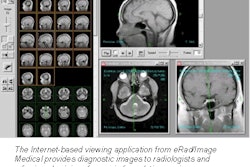WAUKESHA, WI - GE Medical Systems Information Technologies is moving aggressively to broaden its PACS portfolio. The company has allied with broadband communications firm Qwest Communications International for its application service provider (ASP) program, and is also putting the finishing touches on an integrated RIS/PACS network and a common archive infrastructure for medical images.
The exclusive, three-year agreement with Qwest will completely revamp GE's ASP offering. The collaboration will give customers access to images and information stored off-site using dedicated fiber-optic lines. Since the launch of its long-term, off-site ASP program last year, GE has been using traditional long-distance telephone networks. Fifty radiology and cardiology sites in the U.S. are currently using GE ASP services, according to the vendor.
While GE's legacy ASP service was a good fit for smaller institutions, the offering was not as attractive to larger customers due to the stiff cost of providing the necessary wide area network bandwidth for larger image volumes, said Vishal Wanchoo, vice president of radiology systems. Thanks to the relationship with Qwest, GE can now offer sites performing 300,000 imaging exams a year and up an ASP service that's more cost-effective than keeping storage on-site, he said.
In addition to opening the door for broader use of off-site, long-term archiving, GE envisions the outsourcing of all back-end PACS applications, including database servers and short-term storage.
"Long-term we see [on-site] Web-enabled workstations that are connected to the data center," he said. "That offloads a lot of the IT support required for the hospital, the whole database management, [the question of] how to expand short-term storage, that's all done off-site at data centers."
The fiber-optic connections will also confer enhanced security, reliability, and scalability advantages over traditional telephone networking, he said.
Qwest will store and manage the images at its Web-hosting CyberCenters around the world. Initially, GE plans to target large institutions and integrated delivery networks in metropolitan and surrounding areas, although it could also support rural clients, Wanchoo said.
The company expects to have a first test site up and running by the 2001 RSNA meeting in Chicago, with general availability scheduled for the first quarter of 2002. It plans to expand the ASP offering to every clinical department in a hospital by 2003, and has ambitious revenue expectations of $250 million for the new service.
GE's former ASP partnership with Emageon will end as a result of the new alliance with Qwest, Wanchoo said. GE's ASP partnership with EMC will continue, however. EMC subsystems will be utilized at Qwest data centers, Wanchoo said.
In a media event held last week in Waukesha, WI, the vendor also offered a glimpse into its integrated RIS/PACS network, set to debut at this year's RSNA meeting. GE has integrated its PathSpeed PACS software with the ProgRIS RIS, which the company acquired from Per-Se Technologies earlier this year.
The PathSpeed and ProgRIS user interfaces, and, most importantly, the databases, have been completely integrated, Wanchoo said.
"The whole theme is that you can do any function required in a clinical department that needs to be done on a RIS or the PACS at a single integrated desktop," he said. "Whether you want to do ordering, to look at new schedules, to change orders, to approve reports, it's all done on this integrated desktop. And if you want to sign reports from an office, it's Web-enabled, and it's exactly the same user interface as the integrated desktop."
GE had been exploring an integrated RIS/PACS through a previous relationship with Cerner, but the acquisition of ProgRIS has allowed GE to accelerate the development process, Wanchoo said. GE plans to place the integrated RIS/PACS into clinical use by the first quarter of 2002, with general availability expected by the second quarter. The vendor will be able to retrofit the integrated RIS/PACS capability to its installed base, he said.
In other planned RSNA introductions, GE will introduce a common image archive infrastructure, which will allow for storage of radiology, cardiology, and any other medical images on the same archive. GE believes a new archive application would give its customers more flexibility.
"This would allow [customers] to essentially partition these image management solution by hospitals, across integrated delivery systems, by departments, and by outpatient clinics," Wanchoo said. "Redundancy and disaster recovery would also be built in."
The company plans to release this offering by the first or second quarter of 2002.
By Erik L. RidleyAuntMinnie.com staff writer
September 3, 2001
Related Reading
GE scores large ASP contract from HealthHelp, August 7, 2001
GE debuts cardiovascular management system, April 25, 2001
GE acquires ProAct Medical, April 4, 2001
GE enters clinical IS market, February 9, 2001
GE buys Per-Se’s ProgRIS, February 1, 2001
GE readies launch of PACS application service provider program, July 19, 2000
Copyright © 2001 AuntMinnie.com




















